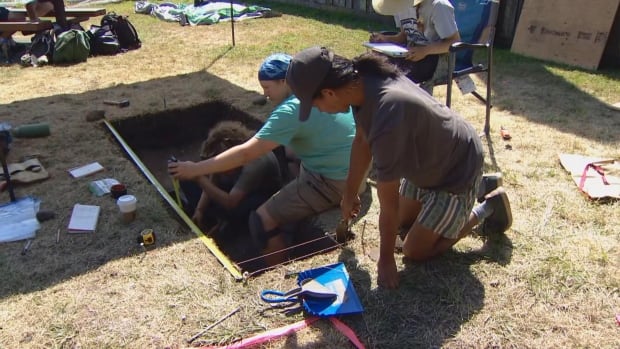An archaeological dig on southern Vancouver Island has uncovered remnants from an ancient W̱SÁNEĆ (wh-say-nutch) village, dating back centuries.
The dig, happening in what is now known as Agate Park in Saanich, B.C.’s Cordova Bay, has taken place through the month of July, where several anthropology students have been on site learning proper techniques.
What they’ve found is the remains of the ancestral village of ȾEL¸IȽĆE (pronounced Tel-eech), which the W̱SÁNEĆ people say is surrounded by burial sites and fishing grounds. It’s estimated at least 250 people lived at the site in the past.
According to Brian Thom, an associate professor with the anthropology department at the University of Victoria, the site was at the centre of the South Saanich Treaty in 1852, which promised to set aside the village site and enclosed fields for the nation to use.
“For whatever reasons, in colonial history, this particular village never did get set aside,” Thom said.
He said Spanish naval maps from the late 1700s show two longhouses at ȾEL¸IȽĆE.
WATCH | Researchers describe what they’ve found at the ancestral village of ȾEL¸IȽĆE on Vancouver Island
Anthropologist Brian Thom explains what his team has found during a dig on southern Vancouver Island.
In 2008, 350 artifacts and the remains of 14 people dating back 1,000 years were uncovered during excavations to develop a waterfront home in the area. Those artifacts were taken to the Royal B.C. Museum.
At this most recent dig in Agate Park, researchers are uncovering things like hunting tools, remains from food and fire hearths.
“We’re finding all of these sort of classic elements of domestic life,” Thom said.

As the dig wraps up, researchers will produce several reports on their findings, Thom said, which will be made publicly available. They also plan to do presentations to show people what they’ve found and learned about life in the area hundreds of years ago.
“We want to really share the knowledge of this incredible village,” Thom said.
Artifacts will be handed over to the Royal B.C. Museum after being analyzed. Thom said the W̱SÁNEĆ are working to have all artifacts at the museum repatriated as a group, and are aware that those found during this dig will be part of that.
Kaia Carr-Meehan, a third-year archaeology student says it’s been a privilege to be part of the project.
“We’re getting to bear witness to a lot of really significant aspects of culture and the lives of human beings upwards of 1,000 years ago,” she said.

For Roger Charlie, a member and spiritual leader of the Tsartlip First Nation who has been on site for the past six weeks, the dig has had even more meaning.
“I’ve been learning about our people for years,” Charlie said. He grew up hearing stories of canoes, ceremonies and feasts, and how his people traveled around the area.
Traditionally there are four W̱SÁNEĆ Nations, including the Tsartlip, Tseycum, Tsawout, and Pauquachin.
Until now, he’s never been able to visualize it.
“I can feel that strength that our people had back then,” Charlie said.
“It feels like I came home.”



